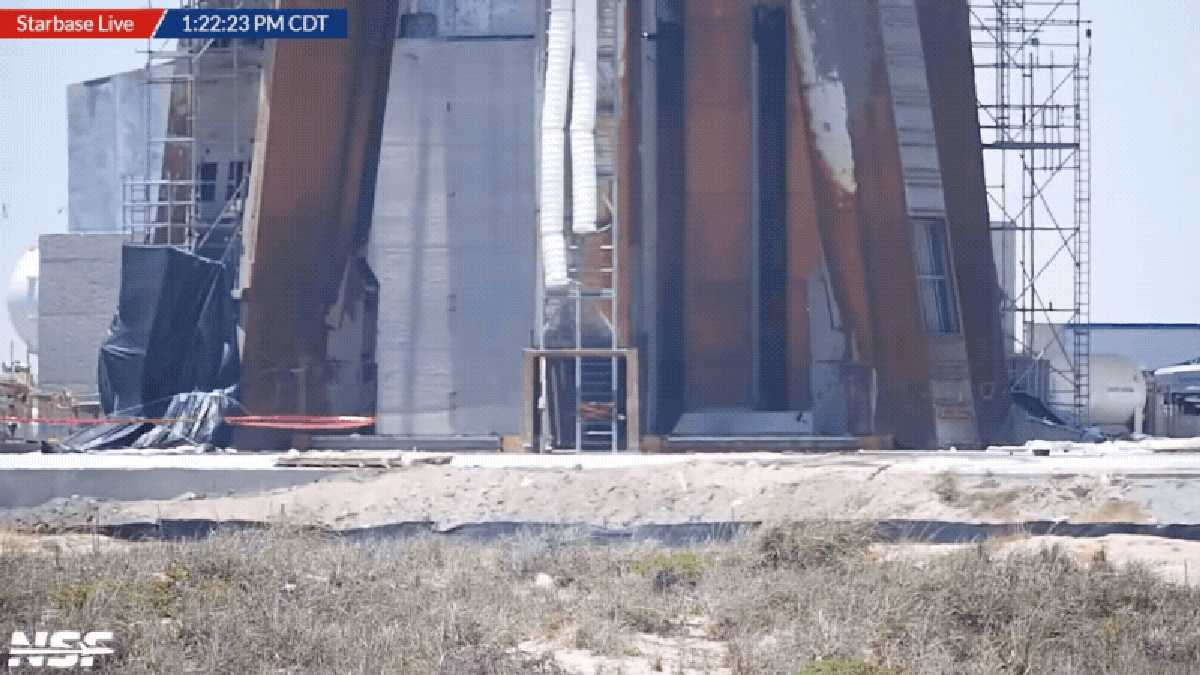On April 20, SpaceX wantonly launched its Starship megarocket without the benefit of a flame diverter or water deluge system, resulting in significant damage to the launch pad and hurtling dust and debris into the surrounding areas. Looking to prevent a recurrence, the company is building a powerful deluge system, which underwent its first test yesterday.
The limited test took place at 2:22 p.m. ET on July 17 at SpaceX’s Starbase facility in Boca Chica, Texas. Video from NASASpaceflight shows thousands of gallons of water shooting up from the orbital launch mount (OLM) with tremendous force. The sound of the water blasting upwards was surprisingly intense. More powerful tests are likely, as SpaceX works towards the next static fire test of Starship, the date of which has not yet been announced. The video below provides multiple shots of the test.
Eventually, the system could spray as much as 350,000 gallons of water during Starship ignition and liftoff, according to the Federal Aviation Administration’s Programmatic Environmental Assessment (PEA) from June 2022. Unlike NASA’s water deluge system, which pumps out 450,000 gallons of water to suppress the excessive noise produced during launches of the Space Launch System (SLS) rocket, SpaceX’s deluge system uses water to absorb energy from the rocket as it lifts off, with most of the water expected to be “vaporized by the heat of the rocket engines,” the FAA said.
That SpaceX should have used a water deluge system back in April is glaringly apparent—and not just because we have the benefit of hindsight. During its inaugural launch, Starship’s 33 Raptor engines, producing nearly 17 million pounds of thrust, scorched the area immediately below the OLM, leaving behind a 25-foot-deep crater and scattering debris and dust over a wide area. In nearby Port Isabel, dust “landed on everything,” as The New York Times reported at the time. The FAA is now facing a lawsuit as a result of allowing the launch, while Starship remains grounded pending an investigation.
The Elon Musk-led company—the most valuable private company in the United States—likely chose to fly Starship without the benefit of launch suppression infrastructure, either because it underplayed the potential risks or because it’s under tremendous pressure to get the rocket up and running; the company is under two lucrative NASA contracts to leverage Starship as a lunar lander for the Artemis 3 and 4 missions. But I’m speculating; only Elon knows the reason. What is clear, however, is that the company was contemplating the idea at the very least, as the FAA’s PEA makes clear:
SpaceX is still determining whether a diverter would be used under the launch mount. A diverter is a metal structure placed on the launch pad underneath the rocket to divert the rocket plume laterally away from the ground. SpaceX is also still considering whether it would use deluge water during a launch or test.
The problematic April flight, in which the 394-foot Starship blew up just four minutes after lift-off, is indeed pushing SpaceX to invest in adequate suppression infrastructure (the metal diverter included). This is a logical move not only for environmental or safety reasons, but also from a financial standpoint. Starship, with its potential to regularly embark on missions to low Earth orbit, the Moon, or even Mars, simply cannot afford to decimate the launch pad after every flight.
For more spaceflight in your life, follow us on Twitter and bookmark Gizmodo’s dedicated Spaceflight page.

